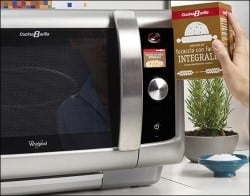Cucina Barilla was launched two years ago across 400 stores in Italy. It has 20 RFID-enabled recipes but is expanding to approximately 100 recipes over the next two years.
ID-Solutions

Andrea Belli, technical project leader, quality and food safety, Barilla, told RFID Journal, on the side of each Barilla recipe kit is an RFID tag.
When a user places the tag near an oven's display screen, a built-in RFID reader captures the tag's ID number and the oven automatically sets the cooking procedure and time.
The initiative began five years ago when Barilla partnered with RFID technology provider ID-Solutions. Together they worked with Whirlpool to develop Cucina Barilla, a specialized Barilla-branded oven.
The oven includes microwave and conventional oven components, as well as a pump and a motor to add water to pasta or other dry ingredients and mix them together.
The oven also has a ‘delay’ function so consumers can program the cooking and have their meal at a time of their choice, for example, fresh bread in the morning.
To automatically program the oven to make each recipe and to display manual instructions for a user, Barilla considered the use of linear or 2D bar codes, in addition to HF or ultrahigh-frequency (UHF) passive RFID tags.
It worked with the University of Parma RFID Lab, in conjunction with ID-Solutions, to determine which technology would be best for the product.
It found 13.56 MHz HF RFID technology compliant with ISO 15693 standard was the best option.
SMARTRAC BullsEye RFID tag
“At first, Barilla did not want the ovens to connect to the internet, so the appliances needed to be able to access instructions for each recipe without having to retrieve them from a server,” said Francesco Fantoni Guerci, CEO, ID-Solutions.
“In addition, because the company intended to add new recipes over time, with the addition of new products, the oven needed to be able to receive new data with the use of each product. Barilla also wanted to ensure each ingredient kit used to make a meal had a unique identifier that the oven would accept only once.
“After a kit was used to make a meal, the oven's reader would no longer recognize its tag's ID, ensuring consumers did not try to use that same tag multiple times but with their own ingredients.”
Barilla wanted to use HF RFID because high-memory HF chips can store a large amount of data and they are inexpensive to install into an oven.
ID-Solutions selected NXP Semiconductors' iCode SLIX chip with 1 kilobit of memory, and designed a customized SMARTRAC BullsEye RFID tag and label that could be attached to the packaging.
The firm encodes each label's tag with the appropriate recipe data, and then sends the labels to Barilla's manufacturing site, where they are applied to the packaging.
To cook a meal, consumers must order an ingredient kit from the Cucina Barilla website. The ovens are sold at most large electronics stores in Italy.
